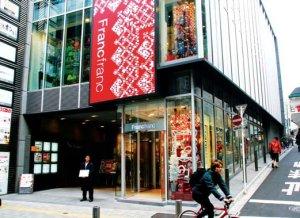Retail Focus -- Made in Japan?
By Kevin Mcgue
 Japanese companies hiding behind foreign branding is now the standard.
Japanese companies hiding behind foreign branding is now the standard.
Foreign branding takes on new life in Japan
In 1959, a Polish-Jewish couple in the Bronx started a small line of ice cream using egg yolk and butterfat rather than the artificial emulsifiers and sweeteners that were standard at the time. Wanting to further set the brand apart by making it appear “Scandinavian,” they christened it “Häagen-Dazs,” a name which doesn’t mean anything in any Scandinavian language, and allowed people to think that it just might be imported. In the 1980s, Häagen-Dazs unsuccessfully filed a trade dress suit against another premium ice cream brand, Frusen Glädjé, which almost means “frozen joy” in Swedish, and which included a map of Scandinavia on the packaging, despite being manufactured in the US.
The pseudo-Swedish ice creams are textbook examples of foreign branding, or the practice of marketers attempting to make domestic products appear as if they were distinguished enough in markets overseas to be selected for import. It is a method pursued with great élan in Japan. It is well known that since the 1980s many Japanese fashion brands have given their clothing lines a foreign feel by using non-Japanese models in runway shows and print ads. However, the history of foreign branding stretches much further back than the heady days of the economic bubble. A visit to the Retro Showa Packaging Museum in Aome, Tokyo, reveals medicine packages from the 1930s featuring fair-skinned, blonde women and product descriptions written in rather unnatural sounding English.
One of the first Japanese companies to learn the power of foreign branding started life under the not-so-catchy name of Shokosha Watch Research Institute in 1918. It released a new wristwatch model in 1924, a time when most watches in Japan were pocket models that had been imported from England or Switzerland. The company deliberately chose a vaguely British-sounding name to make it appear as if the new model had been imported. The new watch caught on, and in 1930, the company rebranded itself as Citizen.
Today there is a seemingly endless number of foreign-branded companies, shops, and products in Japan, leaving consumers confused as to where things actually originate. When Starbucks opened its first branch in Japan in 1995, people lined up for hours to try a cup of the American coffee. Competitors were quick to respond, and Japanese coffee chain Doutor rebranded a number of its locations as the Starbucks look-a-like Excelsior Caffe. A Tokyo-based company started the chain Caffe Veloce, meaning “fast café” in Italian, which now operates over 170 locations around Japan.
FrancFranc, the interior goods and furniture store with more than 80 locations around Japan, in large part sets the standards of interior design, with simple, stylish furnishings. Despite the French-sounding name, it is in fact operated by Bals Co., Ltd, a Shibuya-based company. A visit to the recently opened four-storey Shibuya branch, the first stand-alone shop in the chain, reveals styles which seem every bit as European as those found at competitors which entered the market after the FrancFranc revolution, such as BoConcept from Denmark, and Ikea from Sweden. It could be argued that FrancFranc primed the Japanese market for the return of Ikea, which unsuccessfully tested the waters here in the 1970s. Today, because of the influence of shops such as FrancFranc, Japanese in their 20s and 30s are much more house-proud than previous generations, preferring to entertain friends at home rather than going out.
On the shelves of FrancFranc are environmentally- friendly household cleaners from Germany alongside goods with descriptions written in English or even French or German, although they are made by Japanese companies for the Japanese market. This is only one indication that English is no longer “foreign” enough for foreign branding. Walk around fashionable centers such as Omotesando in early January, and you are more likely to find “saldi” or “soldes” in shop windows than the less exotic “sale.”
Occasionally foreign companies must reassert their foreignness to stand out in the crowded market. McDonald’s, which caused a sensation when it entered Japan in the early 1970s, now operates more than 3,500 locations in the country and is no longer seen as foreign. Last month, the company rebranded two of its locations in Omotesando and Shibuya as “Quarter Pounder,” removing the trademark golden arches, the McDonald’s name and leaving only minimal menus in English. All to create the illusion of being a new foreign brand in town. JI





